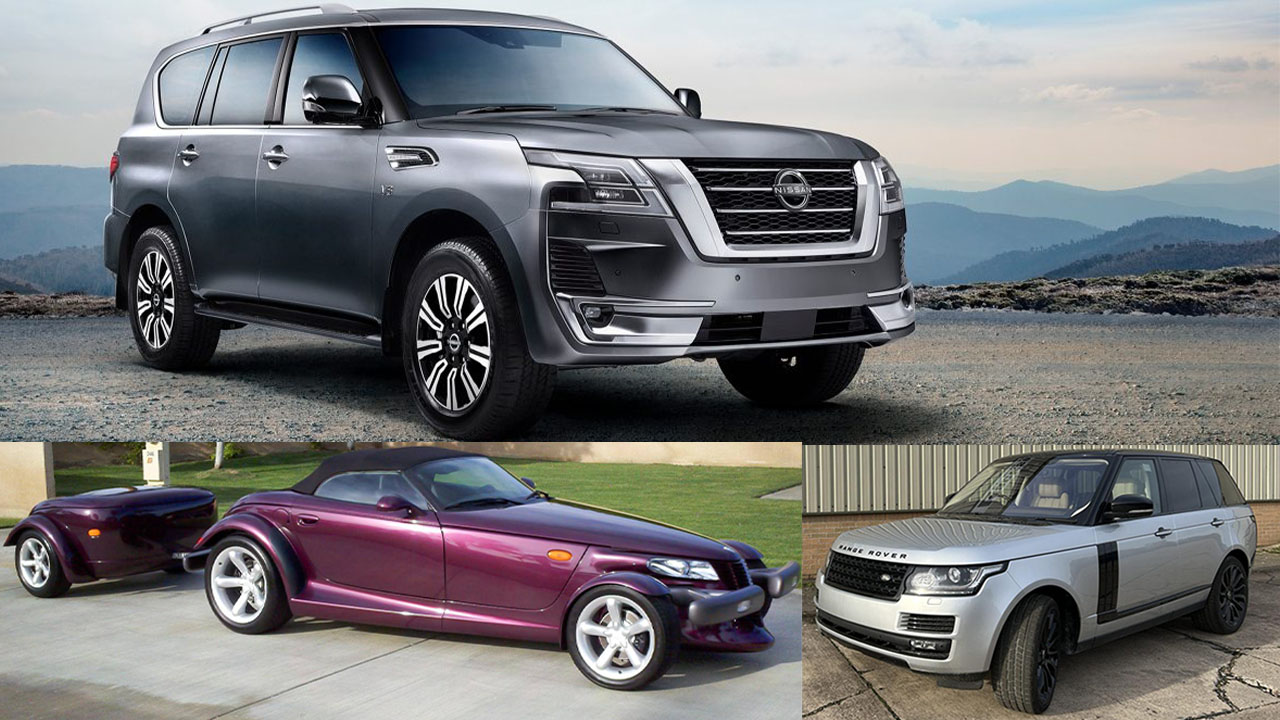If your New Year’s resolution involves spending more time in the mountains, then having a dependable vehicle is non-negotiable.
Tackling steep inclines, rough terrain, and unpredictable weather requires more than just any car—you need a reliable partner that’s built to handle the challenge.
Your choice of vehicle will ultimately determine whether your mountain adventures are smooth and safe or stressful and uncertain.
So, how do you pick the ideal used Toyota car from Japan to accompany you on these rugged journeys? That’s where we come in.
In this article, we’ve curated a list of reliable, high-performing vehicles that are perfect for mountainous terrain—each handpicked for its standout capabilities and performance.
Before diving into specific models, there are several essential factors to keep in mind when choosing a car for mountain driving.
First and foremost, prioritize all-wheel drive (AWD) or four-wheel drive (4WD) capability. These systems offer superior traction, especially when roads get steep, slippery, or uneven.
Next, pay close attention to ground clearance—vehicles with higher clearance are better equipped to avoid damage from rocks, dips, and debris. You’ll also want to consider cargo space, ensuring there’s enough room for all your gear, luggage, and adventure equipment.
And, of course, safety should always be a top priority. Look for features like traction control, hill descent control, and electronic stability systems that help keep you safe on winding, unpredictable mountain roads.
The good news? The market for used Toyota cars from Japan offers a wide range of models that meet these critical requirements.
We’ve gone ahead and selected the most capable and reliable options to make your decision easier. Stick with us as we take a closer look at these top-performing vehicles, examining their strengths and what makes them ideal for life above sea level.
1. Toyota Hilux
The Toyota Hilux is a durable and well-equipped pickup truck, with a history that dates back to 1968, making it the longest-running pickup truck in production.
Known for its impressive performance, the Hilux is powered by a robust 2.8L diesel engine, allowing it to tow up to 6,700 pounds. This makes it a fantastic option for navigating mountain roads, as it can easily handle rough and uneven terrain.
With its rugged construction, powerful engine, and excellent off-road capabilities, the Hilux is a reliable choice for any adventurous drive.
If your New Year’s resolution involves spending more time in the mountains, then having a dependable vehicle is non-negotiable.
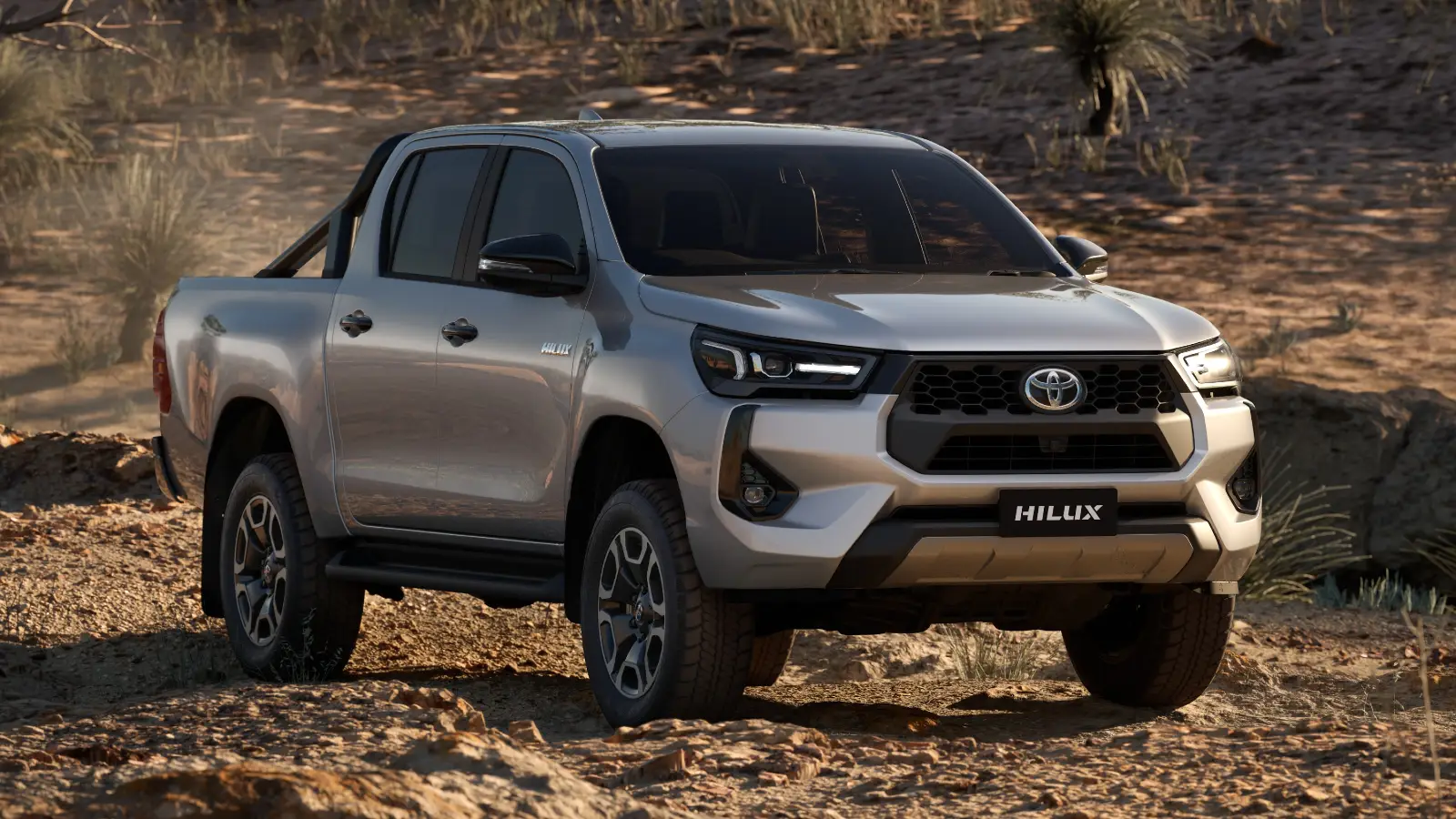
Tackling steep inclines, rough terrain, and unpredictable weather requires more than just any car—you need a reliable partner that’s built to handle the challenge. Your choice of vehicle will ultimately determine whether your mountain adventures are smooth and safe or stressful and uncertain.
So, how do you pick the ideal used Toyota car from Japan to accompany you on these rugged journeys? That’s where we come in. In this article, we’ve curated a list of reliable, high-performing vehicles that are perfect for mountainous terrain—each handpicked for its standout capabilities and performance.
Before diving into specific models, there are several essential factors to keep in mind when choosing a car for mountain driving. First and foremost, prioritize all-wheel drive (AWD) or four-wheel drive (4WD) capability. These systems offer superior traction, especially when roads get steep, slippery, or uneven.
Next, pay close attention to ground clearance—vehicles with higher clearance are better equipped to avoid damage from rocks, dips, and debris. You’ll also want to consider cargo space, ensuring there’s enough room for all your gear, luggage, and adventure equipment.
And, of course, safety should always be a top priority. Look for features like traction control, hill descent control, and electronic stability systems that help keep you safe on winding, unpredictable mountain roads.
The good news? The market for used Toyota cars from Japan offers a wide range of models that meet these critical requirements. We’ve gone ahead and selected the most capable and reliable options to make your decision easier.
Also Read: 10 SUVs That Still Sell High on Craigslist and Facebook
2. Toyota Land Cruiser V6
The Toyota Land Cruiser V6 is an incredibly tough and capable off-road SUV. Initially introduced in 1951 with the FJ20 model, it has undergone numerous improvements over the years.
Powered by a sophisticated four-wheel drive system and a powerful V6 engine, the Land Cruiser V6 is designed for extreme durability.
It has a remarkable towing capacity of up to 8,100 pounds, making it an ideal choice for navigating challenging terrains like mountains.
If you’re someone who enjoys mountain driving, the Land Cruiser V6 is certainly one of the best options available, offering reliability, space, and excellent performance on rugged roads.
The 2025 Land Cruiser stands as Toyota’s rugged, do-it-all SUV, built for tackling just about any terrain you can throw at it.
It underwent a full redesign last year, emerging with refreshed styling, a more compact footprint, and a new powertrain. While the new hybridized turbocharged four-cylinder engine produces less horsepower than the outgoing V8, it delivers significantly improved fuel efficiency.

A full-time four-wheel-drive system, paired with a suite of trail-focused features, makes this SUV exceptionally capable off-road. The most notable update for the 2025 model year is the removal of the First Edition trim level.
Estimated driving costs for the 2025 Toyota Land Cruiser 1958 4dr SUV 4WD (2.4L turbo gas/electric mild hybrid 8-speed automatic) are based on 15,000 miles annually, with an average of 55% city and 45% highway driving.
At the heart of the Land Cruiser’s trail capabilities is its full-time four-wheel-drive system with a low-range transfer case, but that’s just scratching the surface.
Standard on all models are locking center and rear differentials, which maximize traction when navigating rough, rocky paths. There’s also an optional front stabilizer bar that automatically disconnects, boosting front-wheel articulation at the press of a button.
In addition, the Land Cruiser is loaded with tech aimed at off-road enthusiasts, including low-speed crawl control, various terrain-specific traction modes, and available camera views that project onto the dashboard screen to help drivers maneuver through tight, tricky spaces with confidence.
If you’re weighing options, the Jeep Wrangler and Ford Bronco offer top-tier off-road performance and the added thrill of open-air driving, but they trade some of the Land Cruiser’s refinement and comfort.
The Land Rover Defender is another solid contender—it’s stylish and capable, though it comes with a higher price tag.
Then there’s the Toyota 4Runner, which shares much of its engineering DNA with the Land Cruiser. The 4Runner sets itself apart with a broader range of trims and the option of a third-row seat, making it a flexible and family-friendly alternative.
3. Nissan Patrol
The Nissan Patrol is an impressive import from Japan, particularly renowned in the Middle East for its strength and ability to handle difficult off-road conditions.
With a solid frame and a powerful 5.6L V8 engine, it’s built to perform well on rugged terrains. The Patrol also offers valuable off-road features, such as hill descent control and electronic locking differentials, enhancing its capability in tough environments.
In addition, the vehicle is equipped with numerous advanced safety features, providing peace of mind during any adventure. Combining luxury, great towing capacity, and reliability, the Nissan Patrol stands out as an excellent off-road vehicle.
The Nissan Patrol’s primary competitor is the full-size Toyota Land Cruiser, another large off-roader that’s unavailable in Europe, where we only get the smaller ‘Prado’ version. Like the Land Cruiser, the Patrol carries a rugged and upright appearance that reinforces its serious off-road credentials.
At the front, the Patrol features a tall, squared-off bonnet with prominent C-shaped LED headlights that frame a bold and imposing grille.
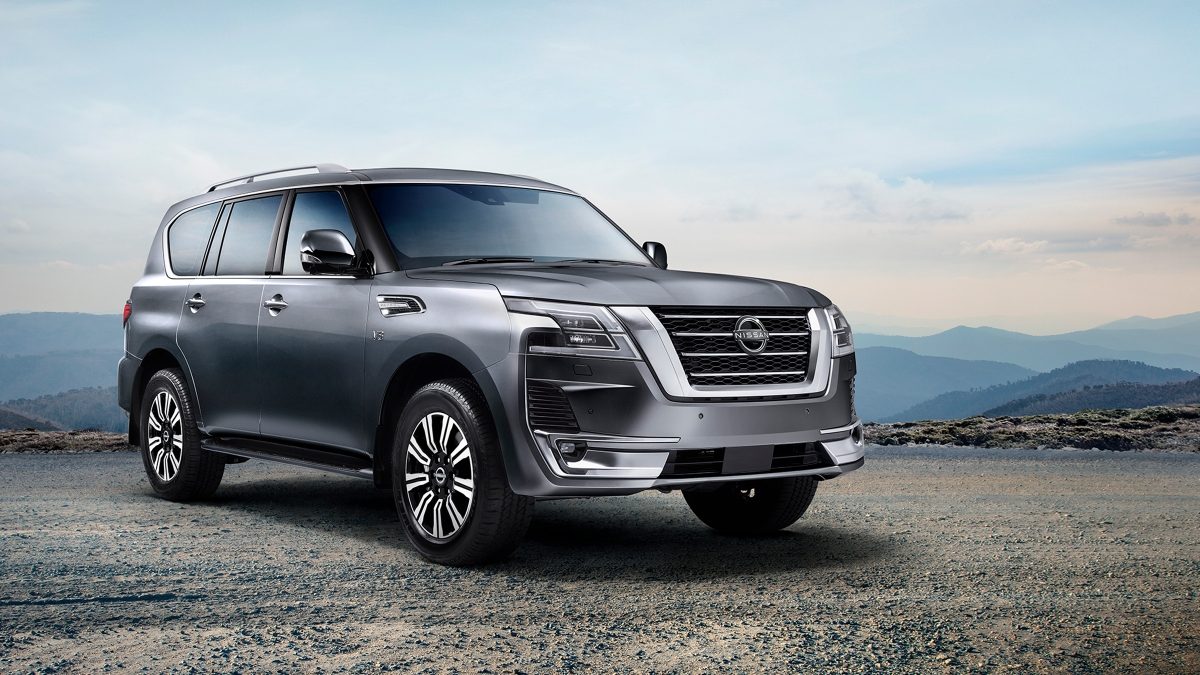
This new generation looks far more modern than the outgoing model, with updates like a light strip stretching across the bonnet and a redesigned lower bumper enhancing its contemporary appeal.
From the side, the latest Patrol retains the same boxy silhouette as the model it replaces. A set of 22-inch alloy wheels wrapped in thick off-road-ready tires adds to its aggressive stance.
Practical additions like side steps ease entry, while gloss black roof rails complete the functional-yet-stylish exterior.
The changes at the rear are subtle but effective. The taillights have been reoriented vertically, giving the SUV a fresh look, and a full-width light bar adds a modern touch to the overall design.
Under the hood, the Patrol now comes equipped with a 3.5-liter V6 petrol engine, replacing the older V8 setup. Even though it has fewer cylinders and a smaller displacement, this new engine delivers more power than its predecessor.
The V6 generates 425 horsepower, which is a 30-hp improvement over the previous model, along with 700Nm of torque. That’s also 10 hp and 50Nm more than the V6-powered Toyota Land Cruiser, giving the new Patrol a noticeable edge in performance.
To ensure that the Patrol is as smooth on city streets as it is capable on rugged trails, Nissan has fitted it with an air suspension system.
This allows the vehicle to be raised for better ground clearance when tackling obstacles and lowered at higher speeds to improve aerodynamics and stability.
4. Honda CR-V
The Honda CR-V is widely regarded as one of the best SUVs in the world. Since its debut in 1995, it has evolved into its fifth generation, maintaining a strong reputation for reliability and fuel efficiency.
A standout feature of this SUV is the magic seat, which increases seating space and offers smooth handling along with responsive steering.
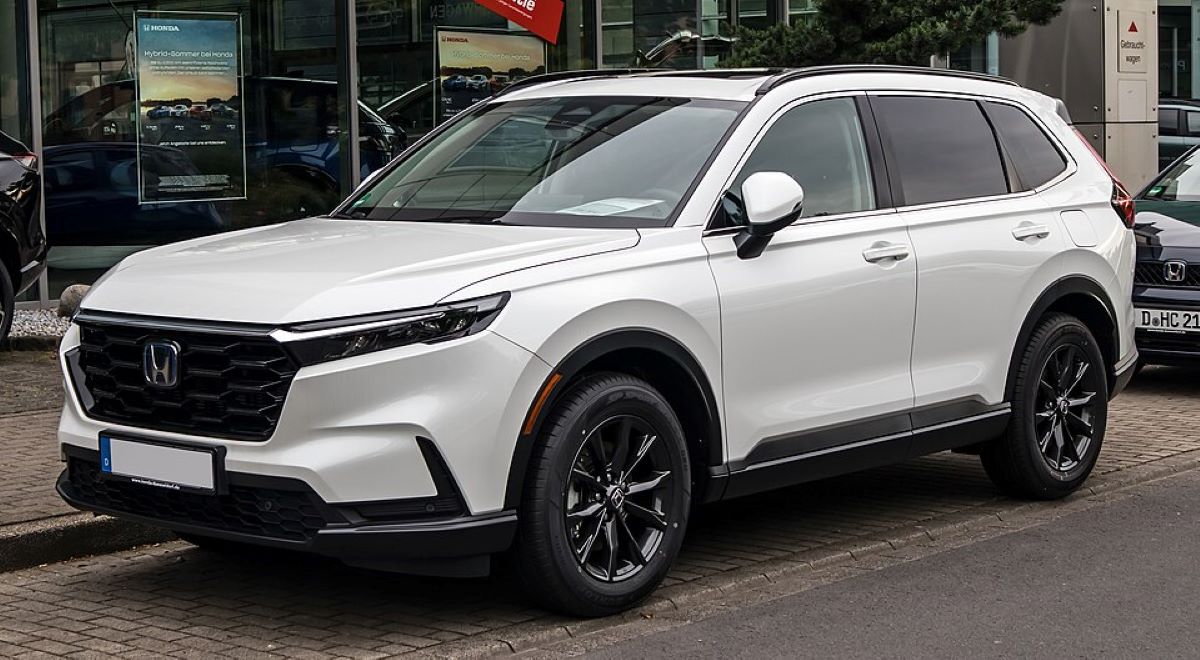
Additionally, the CR-V comes equipped with progressive safety features, making it an excellent choice for driving in the mountains. With its balance of comfort, durability, and efficiency, the Honda CR-V is a well-rounded vehicle for a variety of driving needs.
Honda’s slogan is undoubtedly one of the most fitting in the automotive world—because dreaming big is exactly what the brand encourages. Whether it’s a superbike, a private jet, a powerful boat engine, or in this case, the versatile Honda CR-V, the company’s vision spans far and wide.
The previous generation of the CR-V marked a shift from traditional petrol engines to a standard hybrid system, dubbed the e:HEV.
With the latest version, Honda has broadened its offering, now including not only the e:HEV but also a petrol plug-in hybrid variant, the e:PHEV. This new model represents Honda’s first—and so far, only—plug-in hybrid for the UK market.
While it’s a strong start, the CR-V PHEV enters a competitive segment filled with capable alternatives like the Kia Sorento, Land Rover Discovery Sport, and Lexus NX.
Meanwhile, the regular hybrid version also faces stiff competition from popular family SUVs such as the Kia Sportage and Volkswagen Tiguan.
Nevertheless, the CR-V holds its own with several strengths. It delivers sharp driving dynamics and comes loaded with standard features. However, it doesn’t quite lead the pack due to its noticeable road noise on motorways and limited rear headroom.
For private buyers, the e:HEV in Elegance trim stands out as the most practical choice, while the e:PHEV is better suited to company car users thanks to its plug-in capabilities.
One of the CR-V’s strong suits is its spacious boot and versatile rear seating arrangement, along with a hybrid system that performs efficiently in urban environments.
The handling feels secure and composed. On the downside, it carries a higher price tag than some rivals, and although it’s refined in many areas, the interior doesn’t quite match the premium feel found in competing models.
Pricing for the new CR-V starts at £39,930, with monthly estimates from £505 or leasing from £533. The Honda CR-V 2.0 eHEV Elegance Sensing 5dr eCVT, priced at £45,925, is a well-rounded choice offering good value and performance.
On the road, the CR-V impresses with smooth power delivery. The plug-in hybrid (e:PHEV) boasts a competitive electric-only range, but both versions experience a bit more road noise than you’d expect in this class.
Performance-wise, both variants use a 2.0-litre four-cylinder petrol engine combined with an electric motor to produce 181bhp.
The e:HEV model features four-wheel drive, while the e:PHEV is front-wheel drive and equipped with a larger 17.7kWh battery, allowing for longer electric range.
In testing, the e:HEV reached 0–60mph in 8.4 seconds—respectable, though not class-leading. The e:PHEV edges out a slightly faster time but still falls short of high-performance competitors like the Lexus NX 450h, which sprinted to 60mph in just 5.8 seconds.
Real-world electric range for the CR-V e:PHEV came in at 37.6 miles—short of the official 51-mile claim, yet marginally ahead of the 36.8 miles achieved by the NX 450h under identical conditions.
The CR-V PHEV also proves capable when it comes to towing. Thanks to a specific mode that combines engine and motor output, it can tow up to 1500kg—matching the capacity of both the Lexus NX and Kia Sorento.
This balance of utility, efficiency, and hybrid versatility makes the CR-V a well-rounded contender in the family SUV segment, even if it doesn’t quite claim the top spot.
5. Nissan X Trail
The Nissan X Trail stands in contrast to the larger, more robust Nissan Patrol, as it is a medium-sized SUV designed with comfort and fuel efficiency in mind.
Powered by a reliable 2.5L 4-cylinder engine, the X Trail offers a spacious interior and comes at a reasonable price, making it a dependable option for those who enjoy off-road driving but prefer a more budget-friendly choice.
With its combination of performance, comfort, and affordability, the Nissan X Trail is a practical and efficient vehicle for many drivers.
This marks the fourth generation of Nissan’s flagship SUV—hard to believe, isn’t it? The X-Trail first hit the market in 2001 as a budget-friendly, chunky pseudo-4×4, part of the early wave of soft-roaders that also included the Toyota RAV4 and Land Rover Discovery Sport.
Much like its early peers, the X-Trail has undergone a steady transformation over the years, gradually shedding its rough-and-ready image for a more refined and upscale look.
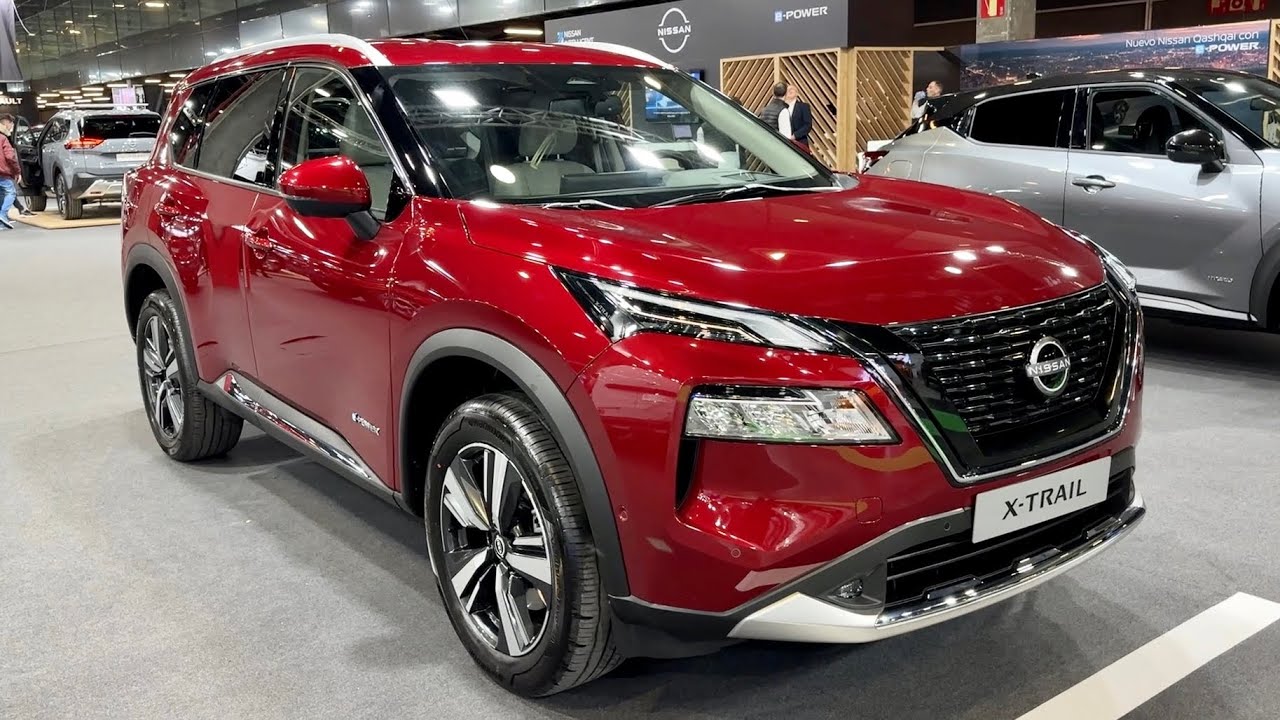
Nissan has clearly aimed to replicate the success of its popular Qashqai crossover by scaling up the formula into a larger, more versatile package.
One of the X-Trail’s standout features is its availability with seven seats, making it a solid choice for families. And now, thanks to Nissan’s unconventional petrol hybrid powertrain, it offers improved fuel efficiency as well.
he big question is whether these upgrades are enough to give it a competitive edge over more well-rounded options like the Skoda Kodiaq, Kia Sorento, or the budget-conscious Dacia Jogger.
At first glance, everything feels familiar: fill up the tank with petrol, step on the accelerator, and the car goes. For many drivers, what happens under the hood isn’t a concern—but Nissan’s e-Power system does things differently.
The 1.5-litre three-cylinder petrol engine doesn’t drive the wheels directly. Instead, all propulsion comes from a 201bhp electric motor.
The petrol engine serves solely as a generator, and it incorporates advanced tech that adjusts its compression ratio on the fly, improving fuel efficiency depending on engine load.
By default, the X-Trail comes with two-wheel drive. However, you can opt for a four-wheel-drive version, which Nissan brands as e-4orce.
This upgrade adds an extra 134bhp electric motor on the rear axle. The system’s onboard computers manage power distribution intelligently, delivering traction exactly where it’s needed. As a result, the 4×4 variant of the X-Trail puts out a combined 211bhp at the wheels.
Cars That Might Struggle With Hills
I suppose there truly is a car out there for everyone. As car enthusiasts, we tend to be quite critical when a car falls short of expectations.
However, the flip side is that we can also develop a deep affection and loyalty toward certain cars, especially when we see something cool or unique about them.
Last week, we asked our readers what “bad car hills” they’d be willing to die on. Here are their responses.
Tesla Cybertruck
I already know this take won’t go down easy, but hear me out—I actually like the Cybertruck. Not because it’s particularly good, or practical, or even remotely likely to fulfill most of the outlandish claims Tesla has made about it (which are as endless as they are ridiculous).
I like it because it dares to be different. It’s bold, polarizing, and it sparks strong reactions from both its fans and its critics.
Innovation doesn’t always have to hit the mark, and that’s perfectly fine. Some of the most forward-thinking companies in history have put out products that ended up being weird misfires—think the Nintendo Virtual Boy, the Windows Phone, or the Apple Pippin.
The Cybertruck feels more like a provocative statement than a truly useful vehicle, but there’s something fascinating about the way it stirs up the same kind of passionate debate among car enthusiasts as a Miata does—though in an entirely different direction.
And that’s the thing: 99 percent of new cars, especially mid-size SUV clones, pass by without anyone noticing or caring. The Cybertruck, whether you love it or hate it, forces you to pay attention. That alone makes its existence worthwhile to me.
As of this writing, Tesla has not announced any updates for the 2026 Cybertruck. That could change at any moment, as the company is known for rolling out new or improved features through over-the-air software updates.
One long-awaited feature, however, appears to have quietly been sidelined—possibly for good. The extended-range bed-mounted battery option, once listed in Tesla’s online configurator, has now vanished.
This has disappointed Cybertruck enthusiasts who were hoping for a model capable of delivering over 400 miles of range. In our Range Test, the Cybertruck maxed out at 334 miles.
The $16,000 add-on had already seen delays in the past, so it’s unclear whether this latest development is just another postponement or an unspoken cancellation.
That said, there is still potential for a battery upgrade to make its way into the standard Cybertruck offering. Tesla’s new 4680 battery program seems poised for launch.
These next-gen batteries incorporate dry cathode technology, which promises to simplify production, reduce costs, and increase energy density—all while fitting into the same or an even smaller physical space than current battery cells.
Pontiac G6 Coupe
“I loved the look of mine.” Honestly, liking how your car looks is a valid reason to stand by it. And to be fair, the G6 wasn’t a terrible ride.
If you skipped the dreadful 3.9-liter engine and opted for the later models with the 3.6-liter V6, you got a sleek coupe (or a retractable hardtop convertible, or even a budget sedan) with 252 horsepower.
The real issue was Pontiac trying too hard to appeal to the tuner crowd and come off as edgy. That strategy gave us the awkward G6 GXP Street Edition—an aesthetic misstep that didn’t deliver any extra speed over the standard GXP. A shame, really.
The 2009 Pontiac G6 offers a convertible with a retractable hardtop, good fuel economy when paired with the six-speed automatic transmission, and responsive handling.
However, there are some notable drawbacks, including low-quality interior plastics, limited rear headroom, unresponsive steering in base sedan models, lackluster brakes, no usable cargo space when the convertible top is retracted, and poor fuel economy with the 3.9-liter V6 engine.
Additionally, the convertible’s crash test ratings are disappointing. For the 2009 model year, the base four-cylinder G6 now has an optional six-speed automatic transmission, which boosts its highway fuel efficiency to 33 mpg.
Satellite radio is standard on all G6 models, and trim levels and option packages have been slightly rearranged. However, power-adjustable pedals are no longer available.
Plymouth Prowler
Sure, it only came with a V6. And yeah, if you wanted usable trunk space, you had to haul around a matching Prowler trailer.
Plymouth threw caution to the wind with the Prowler—a bold, modern take on the classic hot rod—and it ended up being a fitting, badass farewell for the brand. Props to Plymouth for having the guts to greenlight such a wild, head-turning design.
Even 25 years later, it still looks absolutely stunning. Because most owners treated them more like showpieces than daily drivers, there are still plenty of Prowlers out there in fantastic condition. If I had space in a 3-car garage, this would definitely be one of them—abso-effing-lutely.
I used to be one of the people saying it needed a V8. And yes, Chrysler did build a V8-powered concept version called the Howler. But you know what? The Prowler didn’t need the extra cylinders. It was always just fine the way it was—and it still turns heads like nothing else.
Lexus SC (Second Generation)
“These look pretty great, have a killer engine, and are aging gracefully. runs, ducks”. I never really got why this generation of the SC caught so much flak. Sure, the styling may not have blown everyone away, but it wasn’t terrible either.
Time has been kind to it—they’ve aged with a certain quiet elegance. They’re affordable, they’re ridiculously reliable, and you’re way more likely to have a stress-free ownership experience compared to something like a Mercedes SL or a BMW 6 Series from the same era.
The 2009 Pontiac G6 offers a convertible with a retractable hardtop, good fuel economy when paired with the six-speed automatic transmission, and responsive handling.
However, there are some notable drawbacks, including low-quality interior plastics, limited rear headroom, unresponsive steering in base sedan models, lackluster brakes, no usable cargo space when the convertible top is retracted, and poor fuel economy with the 3.9-liter V6 engine. Additionally, the convertible’s crash test ratings are disappointing.
For the 2009 model year, the base four-cylinder G6 now has an optional six-speed automatic transmission, which boosts its highway fuel efficiency to 33 mpg.
Satellite radio is standard on all G6 models, and trim levels and option packages have been slightly rearranged. However, power-adjustable pedals are no longer available.
Range Rover (L405)
“People will always come out saying, ‘but they are so unreliable.’” That critique is mostly fair—if you’re talking about Range Rovers from 20+ years ago.
Later L322s from 2008 onward got significantly better, and the L405 generation improved things even more (aside from known issues like timing chain guides and coolant crossover pipes).
With proper and timely maintenance, modern Range Rovers can actually be dependable. They are complex machines—adjustable air suspension, active anti-roll bars, locking differentials—but if you’re on top of the upkeep, they hold up. That said… owning one without an extended warranty? You’re braver than most.
Personally, the L405 is my favorite generation. I’d gladly own one—just not with a V8. And yes, that warranty is non-negotiable.
While I stand by my enthusiasm for last week’s C4 Chevrolet Corvette Brave Pill, which was met with some mild skepticism in the comments, this week’s offering takes things up a notch.
It’s no longer just a light decision—this time, it’s like playing expiry date roulette with something that’s been lingering in the back of the fridge for far too long. Yes, I’m talking about the classic risk-taker’s companion: a well-worn Range Rover.
Specifically, a still sharp-looking L405 generation model, one that boasts a hefty mileage and a price tag sure to make wallets twitch. And to make things even more thrilling, it’s powered by a V8.
For those with long memories or quick Google skills, you might recall this is the second L405 Range Rover to appear here. The first, a diesel SDV8, was featured in May 2021.
That particular model made history as the first car to be “Pill’d” while still in production, a feat this week’s example won’t match due to the release of the all-new L460 generation Range Rover last year. As a result, this particular Pill will likely appeal less to those chasing the latest trends.
Reflecting this shift, the vehicle’s value has seen a drop. The earlier SDV8 was priced at £24,000, making it the cheapest of its kind in the country at the time. This time around, the price has dropped even further to a very reasonable £21,995.
This example is also a more luxurious Autobiography model, compared to the Vogue trim of the diesel. It also packs the more powerful and more charismatic 5.0-litre supercharged petrol V8, which has long been the heart of the L405’s appeal.
While the arrival of its successor has placed the L405 in a more dated position, it remains a remarkable vehicle. The L405’s debut in 2013 marked Land Rover’s shift toward an even more upscale direction.
While the L494 Range Rover Sport shared the same mechanical foundation and was comparable in size to the older L322 Range Rover, the L405 grew in both size and luxury, becoming even more expensive.
This strategy paid off spectacularly, as the rise of ultra-luxury SUVs like the Bentley Bentayga and Aston Martin DBX can be traced back to the success of the L405, proving there was a market for high-end off-roaders.
The Range Rover Sport’s sportier focus allowed the full-sized Range Rover to prioritize comfort and luxury, offering incredibly smooth air suspension and a driving experience that’s almost as relaxing as being in bed.
Very few luxury cars, regardless of price, have matched the effortless glide of this Range Rover, especially when paired with the powerful 5.0-litre V8.
Despite weighing over two and a half tonnes, the 510hp V8 ensures that the Range Rover accelerates from 0-62mph in just 5.4 seconds, faster than many sports cars—at least in a straight line.
However, the soft suspension means that aggressive acceleration or attempts at rapid progress will result in noticeable body movements, such as pitch, dive, and roll. The best way to enjoy this vehicle is to gently press the accelerator and coast along in commanding comfort.
While few L405s have ventured off-road, especially not ones with the 22-inch diamond cut alloys like this particular Pill, the confidence that these vehicles can handle the wilderness far better than most rivals is built into the package.

